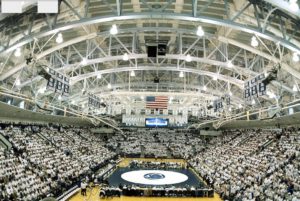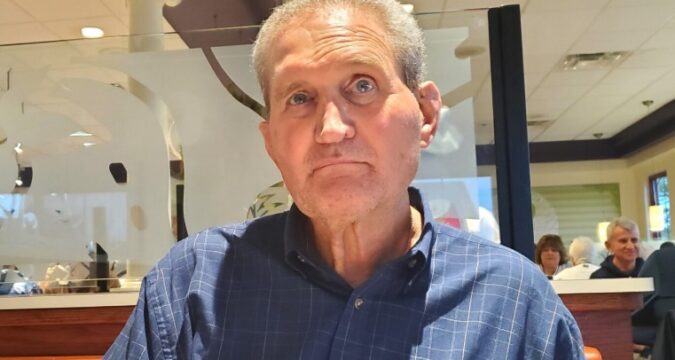
By Bill Horlacher – statecollege.com February 25, 2024
What in the world is going on with college sports? That’s a question I ask myself many times each week, and I’m certainly not the only one. About two weeks ago, Maryland football coach Mike Locksley noted that he struggles to find time for actualcoaching since he must give so much attention to recruiting and fundraising. “My hope,” said Locksley on the
BMitch & Finlay radio show, “is that we can put a guardrail around the NIL and the transfer portal stuff andcreate more accountability…”
And then Locksley illustrated the problem with one glaring example: “Your third-team tailback coming in and saying, ‘I need $100,000 or I’m going into the portal.’ And you’re like, ‘Where does this magic $100,000 number come from?’”
Just a few days ago, Nick Saban offered a critique of college football that was even broader. “What we have now is not college football, not college football as we know it,” said Alabama’s recently-retired coaching legend. “You hear somebody use the word ‘student-athlete.’ That doesn’t exist. We’ve gone to nobody talking about education, nobody talking about creating value for their future, to talking about how much money I canmake while I’m in college.”
Yes, the canaries are croaking in the coal mines, but it’s clear to me that more voices must be raised until something changes. And that’s why I sat down with a senior statesman in our local athletic community, Rich Lorenzo, to discuss the professionalization of collegiate sports.
Lorenzo has the necessary character to assess the problems — he’s a kind soul but he speaks frankly — and he’s got the background. As an athlete, Lorenzo wrestled for Penn State in the 1960s, taking fourth place at the 1968 NCAA championships. As a head coach, he led the Nittany Lions from 1978 to 1992 with 11 of his teams finishing in the nation’s top 10. As an administrator, he served as co-executive director of the National Wrestling Coaches Association. And as a fund-raiser, he successfully brought in nearly $6 million for Penn State’s wrestling facility (named “Lorenzo Wrestling Complex,” despite his objections).
The following are edited portions of our recent conversation in the Lorenzo home near Bellefonte.
Rich, how would you summarize the direction of collegiate sports in this era of Name, Image and
Likeness?
Lorenzo: I think they’re upside down. I really do. I think they’re ass-backwards right now. I feel they’re missing the whole educational goal of academics and athletics — that the student athlete can be working to be the best in whatever challenge is presented. But now it’s like, “I wonder how much I can get?” It’s so important to be able to go through a sport and to be able to learn the lessons of dedication, commitment, failure and success. Yet it looks like that’s number three on a two-item agenda.
We’ve just looked away from all the rules and things we had to follow all those years. The system was not broken. What’s breaking things is the price that’s going to be put on all these things like “image.”
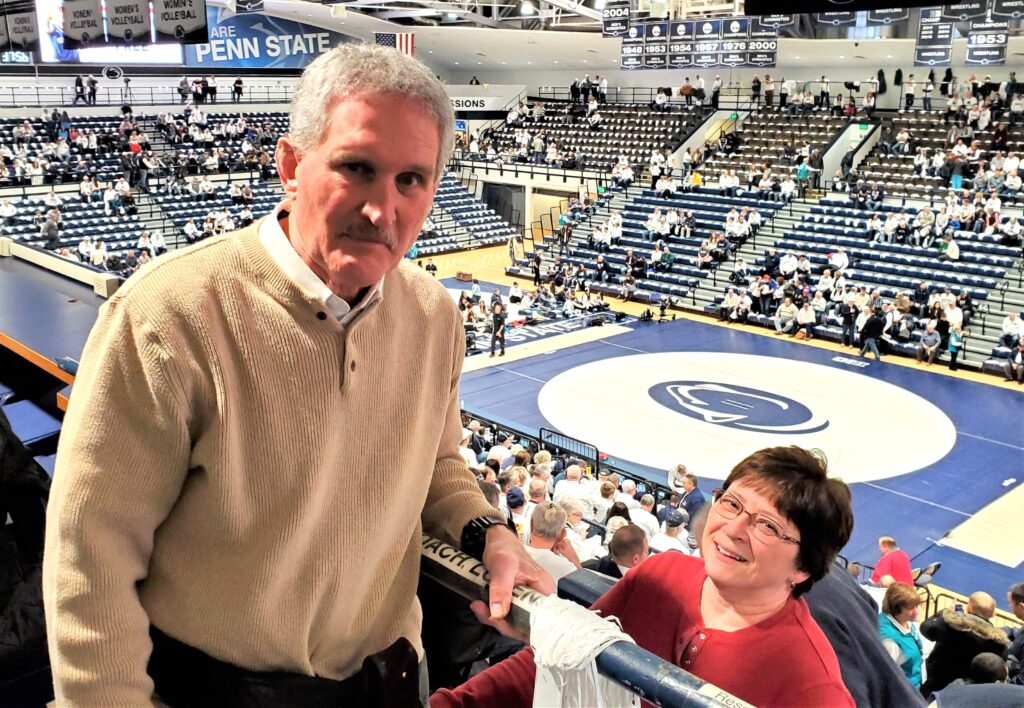
Rich Lorenzo and his wife, Cindy, at a Penn State wrestling meet in Rec Hall. Photo by Bill Horlacher
I’m not sure who said several years ago that NCAA sports had become the wild, wild west — it might have been our own James Franklin. But it seems like that phrase still applies…
Lorenzo: The wild, wild west, oh yeah. Well, basically us old-timers don’t understand a kid getting hundreds of thousands of dollars to join a team. There’s something wrong with this. And at a university that has so many demands just in the academic area…We’re going to dish out this kind if money and get it from people who already have an interest in that university. So they’re going to pump their money into this NIL fund.
It’s going to make it tough for us to support all the sports. For example, you take a guy who gives money to Penn State; he donates money every year. And you take that person and you’ve got something you want done—maybe a new facility for a sport. So you find this guy to support that. Now you’re going to that same guy next week and say, “How about paying this kid who’s going to play in that stadium?” People usually have a certain category and amount that they’re going to donate as tax deductible donations, so they’re going to sit there and say, “I just gave you $100,000 and now you’re back asking me to give you $50,000 more. Where am I going to get the ‘more’ from?”
Big money in collegiate sports must be shocking to you. Wrestling tends to be more popular in rural areas, so I assume most of your teammates and the athletes you coached had to be frugal to get through Penn State.
Lorenzo: Well, first of all, I was a walk-on. I never got a dollar until my senior year.
Really?
Lorenzo: Yeah. I never asked for it, either, because I was getting so wealthy from the knowledge I was gaining and the experience that I was gaining and the opportunities to represent your university and keep rivalries going and build new ones. And so I was just very thankful to my parents and other people — my brother and sister — who supported me to have the opportunity to wrestle here.
I know you grew up on a dairy farm, so you probably didn’t have a lot of money behind you.
Lorenzo: Basically, we’d get up at four o’clock in the morning and we’d milk cows. And then go to school or go to the fields and start working. On a good evening I’d get done around 6 p.m., but a lot of times it wasn’t until dark. Especially if we were out harvesting. And then the other thing you learn real quick when you’re a dairy farmer, there’s no such thing as being sick and “I can’t work this day.” You’ve got to be there, to feed them and you’ve got to milk them at least twice a day. Seven days a week, 365 days a year.
So you finally got a scholarship for your senior year that provided tuition, room and board — in
addition to the free coaching and training you’d already been getting. Do you think the value of those things is being overlooked in the rush for NIL money?
Lorenzo: Yes. A person who receives all that and now we’re going to give him more? He had everything —the cake with all the icing, but maybe the icing didn’t cover one corner of the cake.
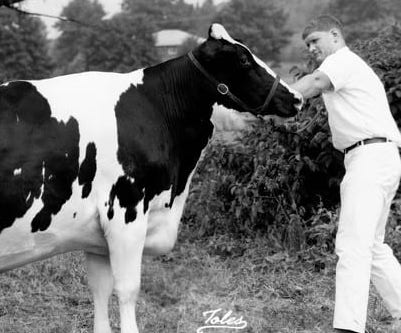
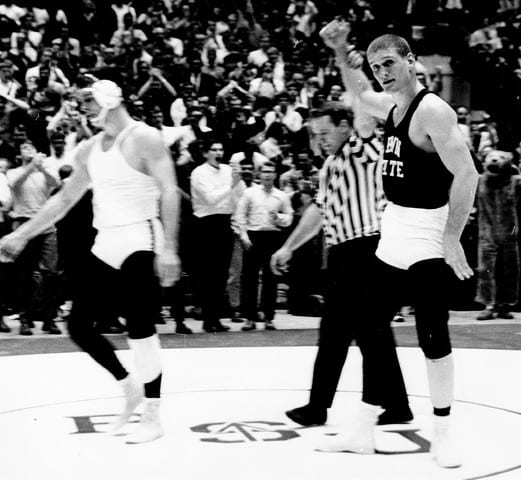
Rich Lorenzo on the farm and on the mat.
Are you mainly concerned that major donors will divert their money from mainstream athletic or
academic budgets in order to fund NIL? Or that they’ll just get turned off by the whole mess and stop giving anything to their favorite university?
Lorenzo: If I was a big Penn State supporter, why would I give money when these kids are making more
than I did for the first 10 years of my career? We’re paying ‘em whatever the heck they want. I guess we’ll see how it all works, but I think we’re going to run out of money. That’s what scares me. It’s a worry about what happens when donors die or they swing their money other directions, to hospitals and charities. And then you’ve got all these other schools outbidding you for athletes. How do we continue this pace?
If we ever get any control over the situation, we’re going to have to make sure we have the money to support the other sports. Football and basketball pay the way, but we need the other sports. I care about the kid who puts a tennis ball in his hand or jumps in a swimming pool. We don’t want to ever lose those sports. And yet that’s what I’m afraid of. We’re going to start losing the emphasis of athletics in a person’s development during his or her school years.
Let’s talk about the situation with the Penn State wrestling program. Obviously, Cael Sanderson has taken his team to an historic level of success, and I’m sure that attracts donor dollars. But this could also be a scary time when everything in college athletics is being redefined.
Lorenzo: I couldn’t be happier for the program and the people on the staff. Cael has a great combination of people who complement him and each other. Cael and his people are doing a great job of paying attention to details and paying attention to the person, to the athlete. Each kid has got to grow, has got to be humble but also has to display confidence to present himself on a mat, in a classroom or in a job interview.
But what can you say about Penn State wrestling in this NIL era? I’m sure Penn State wrestling is
financially solid right now, but what if other Big Ten schools cut wrestling because of a lack of
funding — especially as expenses keep rising?
Lorenzo: In this environment, I would be surprised if a few of the marginal programs in the Big Ten didn’t drop wrestling in the future. It’s becoming very difficult for them to be competitive because they don’t have the financial backers to offset the continued financial drain that’s affecting all sports.
Obviously, Iowa’s wrestling program isn’t going anywhere and I’m sure schools like Ohio State,
Michigan and Minnesota will fund wrestling for the foreseeable future. But what about Maryland or Indiana or Purdue, and how would Penn State be affected if other schools drop wrestling?
Lorenzo: We could be very vulnerable if our competition’s going to be leaving us. Are they going to be driven out of business for lack of money? NCAA wrestling is not a very big organization. When you look around at the number of universities in the country, a lot of ’em don’t have wrestling. There are now only 78 Division 1 programs in wrestling.
Speaking of money for Penn State wrestling, I know you launched a program years ago for various
donors to endow scholarships for various weight classes. How has that program gone?
Lorenzo: Well, they (weight classes) aren’t all endowed, but a good number of them are. And we wanted to make sure they’d be endowed forever. So I proposed that the financial administrators put in a clause that if the varsity sport is ever dropped at Penn State, the money will go to sponsor a wrestling club and coaches’ salaries.
Going back to your broader concern — the professionalization of collegiate sports — what basic
solution would you recommend?
Lorenzo: What’s the fastest way for us to get ahold of this monster? Well, we’ve got to challenge the university presidents. As an NCAA staff member told me back in the late 1970s, “The NCAA is your college president, period. We enforce the rules that the college presidents create.”
Let’s challenge the college presidents and athletic directors to not lose sight of the value of education through sports while preserving amateur athletic status. NCAA rules worked in the past. How can they be tweaked to minimize the undue time spent by coaches in continual recruiting? And how can they be adjusted to limit the financial drain that NIL is creating for the universities?
Perhaps the presidents and ADs need to form a committee to take back some of the control that they’ve relinquished. Those collective minds can get together and propose or design or tear down the rules that are going to exist. So if they’re going to be the ones that lead us, they’ve got to lead us. Now. Don’t let it go for years where things are destroyed and you make schools drop programs.

